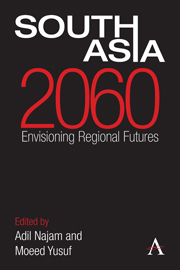Book contents
- Frontmatter
- Contents
- Acknowledgments
- List of Abbreviations
- Introduction: Imagining South Asian Futures
- Section I South Asia as a Region
- Section II State Relations
- Section III Development
- Chapter 16 South Asian Economy in 2060
- Chapter 17 Economic Futures: Challenges Ahead
- Chapter 18 South Asia in the Asian Economy: Struggling to Overcome History
- Chapter 19 Globalization and South Asia
- Chapter 20 Trade Relations: Some Predictions and Lessons
- Chapter 21 Urban Policy for Environmental Quality and Well-Being
- Chapter 22 Urban Futures, Urban Challenges
- Chapter 23 Water Security: Risks and Responses
- Chapter 24 Agriculture and Food Security
- Chapter 25 Meeting Electric Power Demand in South Asia
- Chapter 26 E-South Asia: A Social Science Fiction
- Section IV Human Well-Being
- About the Authors
- Bibliography
- Index
Chapter 19 - Globalization and South Asia
from Section III - Development
Published online by Cambridge University Press: 05 September 2013
- Frontmatter
- Contents
- Acknowledgments
- List of Abbreviations
- Introduction: Imagining South Asian Futures
- Section I South Asia as a Region
- Section II State Relations
- Section III Development
- Chapter 16 South Asian Economy in 2060
- Chapter 17 Economic Futures: Challenges Ahead
- Chapter 18 South Asia in the Asian Economy: Struggling to Overcome History
- Chapter 19 Globalization and South Asia
- Chapter 20 Trade Relations: Some Predictions and Lessons
- Chapter 21 Urban Policy for Environmental Quality and Well-Being
- Chapter 22 Urban Futures, Urban Challenges
- Chapter 23 Water Security: Risks and Responses
- Chapter 24 Agriculture and Food Security
- Chapter 25 Meeting Electric Power Demand in South Asia
- Chapter 26 E-South Asia: A Social Science Fiction
- Section IV Human Well-Being
- About the Authors
- Bibliography
- Index
Summary
South Asia has the highest density of futurists in the world – we call them astrologers. Their methodology for making predictions involves stars and planets and generous doses of credulity. Since I don't have access to their methods, I will have to attempt this exercise using what I know: some core principles and a theory about understanding long-term change.
First, if we begin from a limited understanding of globalization – that it is primarily an economic and cultural phenomenon, that too of recent vintage – then we won't get very far, certainly not to 2060. It is necessary, for sure, to pay attention to economics and culture, and I will do so in this essay. But, I believe, it is necessary to begin by thinking of globalization in terms of ideologies and institutions that create the framework of interactions at a global scale. In this sense, globalization has existed from the time global interaction has been possible; what has changed is the intensity and nature of the interactions, which in turn have been guided by ideologies and institutions.
Second, there is a serious problem with extrapolation. It assumes that the rate and direction of change follows a linear logic. This is similar to a core problem in evolution: is it incremental (an accumulation of minute changes over a very long time) or is it discontinuous (there are accumulated minute changes, no doubt, but there are periods of dramatic and large change)?
- Type
- Chapter
- Information
- South Asia 2060Envisioning Regional Futures, pp. 147 - 152Publisher: Anthem PressPrint publication year: 2013



